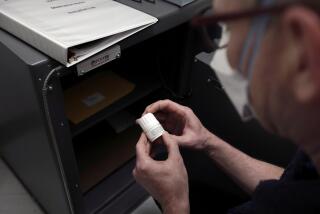Scripps’ Latest Deal Sparks Debate : Research: Critics fault taxpayer- funded lab for giving a foreign firm first crack at technology.
- Share via
When Scripps Research Institute signed a 10-year, $300-million research agreement in December that gives Swiss pharmaceutical giant Sandoz first rights on all technology developed at the La Jolla facility, neither party anticipated the firestorm that was to erupt.
Scripps seemed to be in line with other research laboratories--whether university-run or private--that have increasingly collaborated with the corporate world to make up for growing costs and a scarcity of government funding. Such pacts have rarely generated headlines. For example, Scripps is finishing up a $116-million relationship with New Brunswick, N.J.-based Johnson & Johnson, the world’s largest maker of health care products.
News of the Scripps-Sandoz deal, however, came at a time of intense concern about health care costs--including government scrutiny of pharmaceutical companies whose drug prices have generally risen faster than the rate of inflation. Also fanning the flames is the fact that 60% of Scripps’ budget comes from National Institutes of Health grants--implying that U.S. taxpayers will be helping to finance a foreign firm’s technology development.
Whether Scripps and Sandoz have done anything improper--both vehemently deny they have--the research mega-deal involving one of the United States’ most prestigious labs has put under scrutiny a complex area of public policy that health economists say needs a closer look: ownership of taxpayer-supported research.
The Scripps-Sandoz controversy erupted earlier this month when NIH Director Bernadine Healy, speaking before a congressional subcommittee, described the deal as contrary to the “spirit of science” and possibly illegal.
She complained that Scripps and Sandoz did not consult the NIH prior to the arrangement. The agency did not receive details of the pact until March, three months after it was signed, according to Healy spokeswoman Johanna Schneider. She called that an egregious error given the “triangular” financial partnership the agreement would create between Scripps, Sandoz and the NIH.
Healy also complained that Scripps labs would become off-limits to outside scientists and that Scripps would be legally bound to assist Sandoz in gaining exemption from U.S. laws that prohibit the transfer of government-funded technology to foreign manufacturing facilities.
The House subcommittee on regulation, business opportunities and technology, chaired by Rep. Ron Wyden (D-Ore.), last Monday called for a government probe of the Scripps-Sandoz deal to check for a variety of possible violations of federal law.
Steve Jenning, staff director for the subcommittee, said Congress’ interest in the deal arose out of an overall concern about “the excessive profits of the pharmaceuticals industry and what we can do to perhaps bring some reasonable balance between (drug companies’) justifiable need to make a profit and consumers’ need to afford drugs.”
Sandoz’s exclusive rights to Scripps research could affect drug prices if the government is unable to ensure “fair and reasonable pricing” of drugs developed in collaborations involving government-funded labs. Currently, the government can apply that right only to technology developed at labs entirely funded by the NIH. But some in Congress and the Clinton Administration would like to see that power expanded, Jenning said.
“It’s clear at an early stage that NIH was neither advised nor consulted about this deal, nor would it have a place at the table when the partners decide how to distribute and how to price the fruits of the collaboration,” he said. “What if they find a cure to cancer? That would be a very important drug, and NIH would have utterly no say in the pricing.”
Scripps, an independent research lab founded in 1961, is the fourth-largest recipient of NIH funds among non-university labs. Of its $114.5-million budget last year, $67.4 million came from NIH grants.
Scripps officials insist that Johnson & Johnson got basically the same “first look” rights to its technology as Sandoz will get.
Johnson & Johnson has developed only one drug from its Scripps collaboration, a therapy for hairy-cell leukemia that has a relatively small commercial market. Although several potential drugs based on Scripps technology are in the pipeline, no others are about to receive government approval, said Scripps Senior Vice President Dr. William Beers.
Sandoz, whose 12,000-employee U.S. operation is based in East Hanover, N.J., committed $75 million in funding to the Neurosciences Institute in January and $100 million to the Dana Farber Cancer Institute of Boston in 1991 in exchange for long-term rights to technology. Both Neurosciences and Dana Farber receive NIH money.
Among the drugs Sandoz sells is cyclosporine, a breakthrough drug that reduces the incidence of rejection in organ transplants.
The size of the Sandoz deal was attractive to Scripps because it will enable the lab to plan its budget more effectively. But Beers said the real appeal of the relationship with Sandoz is the “scientific fit”: About 70% of Scripps research projects overlap with what Sandoz is pursuing on its own. Sandoz can request, but not demand, that certain research projects be carried out, Beers said.
He said Scripps scrupulously followed the letter of the law in drawing up the Sandoz agreement and that the controversy “seems to be over existing policies of the U.S. government which we are adhering to. If the Congress wants to implement changes, we’d be happy to abide by them.”
The Bayh-Dole Act of 1980 regulates much of how government-sponsored research is commercialized. The law permitted, for the first time, universities and private research labs to patent government-funded research discoveries under certain guidelines. Above all, applicants must demonstrate an ability and readiness to commercialize the technology, a clause that addressed prior criticism of the government for “sitting on” government-owned discoveries.
The bill does not ban collaborative agreements with foreign firms as long as the products based on the government-sponsored technology are not manufactured offshore.
Dr. David Blumenthal, chief of health policy research and development at Massachusetts General Hospital in Boston, said laboratories such as Scripps that specialize in basic research are under more pressure than most to line up corporate partners because federal research budgets increasingly favor specific research targets, such as a cure for AIDS.
“From the researcher’s viewpoint, they are an additional source of funding at a time (labs) are having trouble maintaining their funding base. Also, they are a way of getting results out more rapidly,” Blumenthal said. “From a company’s standpoint, the benefits are often intangible. They help in education and recruitment of new scientists and (provide a) window in what’s going on in the field.”
Do agreements with foreign drug firms constitute a threat to the nation’s technology base? Blumenthal and other health economists stressed that they weren’t familiar with the details of the Scripps-Sandoz deal, but aren’t categorically opposed to deals like it.
“Firm rules against relationships with foreign companies don’t make any sense until we understand what’s gained and what’s lost,” Blumenthal said. “Money that comes in will seed the U.S. biomedical establishment and it’s possible that Sandoz won’t benefit. The research will get published and it’s just as likely that the basic research that’s funded will serve science generally.”
Katharine Ku, director of the office of technology licensing at Stanford University, said the government is better off promoting research than devising new kinds of price controls. The government effectively has that power in setting reimbursement limits in Medicaid and other government medical insurance programs.
“They can always set price limits when the drug comes out on the market,” Ku said. “What the government should be encouraging is development of technologies.”
Scripps Research Institute at a Glance Location: La Jolla. Chief executive: Dr. Richard Lerner. Founded: 1961, as a division of Scripps Clinic. Incorporated separately in 1991. Research staff: 710, including 640 MDs and Ph.D.s and 70 graduate students. 1992 research budget: $114.5 million, of which $67.4 million, or 59%, came from National Institutes of Health grants, $10 million from corporate collaborative agreements and the rest from private sources.
More to Read
Inside the business of entertainment
The Wide Shot brings you news, analysis and insights on everything from streaming wars to production — and what it all means for the future.
You may occasionally receive promotional content from the Los Angeles Times.










